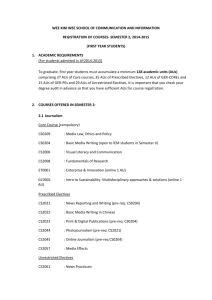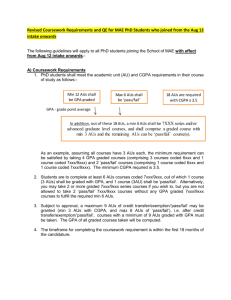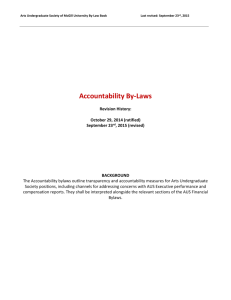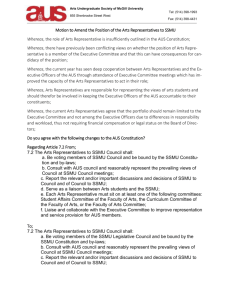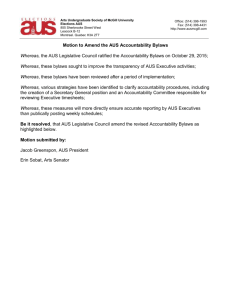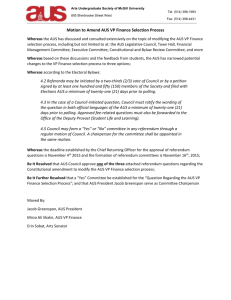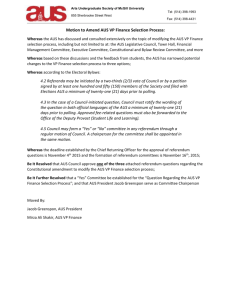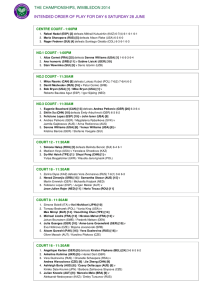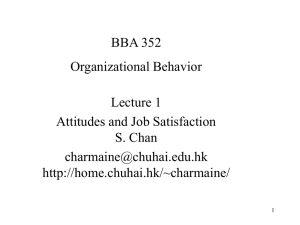Perception is Reality: At Least in Surveys
advertisement
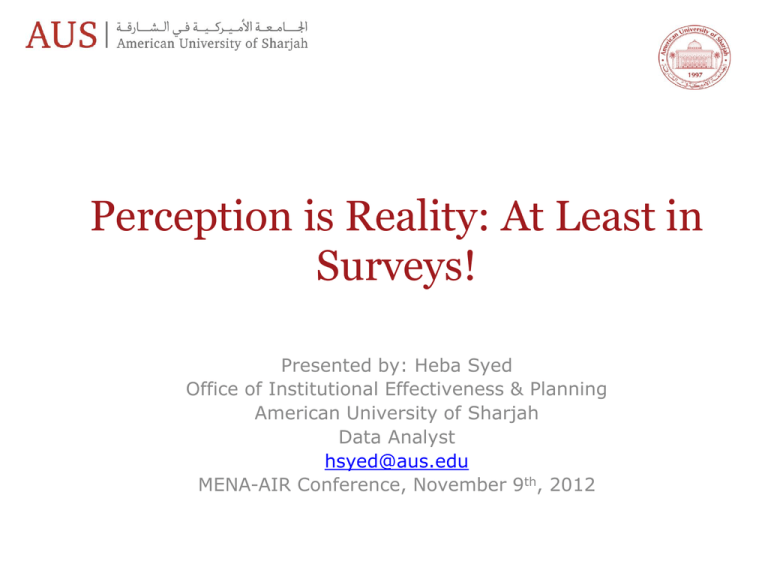
Perception is Reality: At Least in Surveys! Presented by: Heba Syed Office of Institutional Effectiveness & Planning American University of Sharjah Data Analyst hsyed@aus.edu MENA-AIR Conference, November 9th, 2012 “The optimist sees the donut, the pessimist sees the hole.” ― Oscar Wilde 2 Presentation Outline I. GAP Overview- Background and methodology II. Surveys- Insight on student satisfaction III. Survey Analysis within the GAP framework 1) Positive GAPs 2) Negative GAPs IV. Interpretation of results V. Strengths of the GAP VI. Limitations of the GAP VII. Conclusion 3 GAP Overview-Definition How can we change inaccurate perceptions? By performing a Gap Analysis. • A Gap Analysis is the process of comparing two things in order to determine the difference or “gap” that exists between them. • In using student surveys, the two things usually compared are level of satisfaction and level of importance. • Once the gap between these things is understood, the steps (time, money and human resources) required to bridge the gap can be determined. 4 GAP Application • Strategy development • Quality Assurance • Project and Performance management • Forecasting and budgeting • System maintenance and iterative development. 5 GAP 6 The GAP Methodology- AUS Context 1. Attribute identification: Identification of the attributes that AUS considers desirable and where measurements need to be made. 2. Identify the benchmark: Once lists of attributes are determined, the mean of ideal state need to be listed for each of the attributes in the list. These means serve as the benchmark against which the comparisons are made against student’s rating of the university. 3. Comparison: The next step involves calculating the point difference between the two means. Positive differences indicate AUS is performing better than the benchmark. On the contrary, a negative result indicates AUS is performing below the benchmark in which case, attention needs to be given to reduce and eventually eliminate the gaps. Underperforming Outperforming Mean difference 7 The GAP Methodology Admitted but not enroll Identification of important attributes at AUS First time in College Graduating survey Faculty & Staff survey Survey Deployment GAP ANALYSES Identification of ideal performance levels Early Leavers Survey Alumni Survey Action plan /policy development and implementation Identification of organizational performance YES GAP positive? NO 8 Surveys: Tools of Satisfaction 1. First Time in College Survey 2. Admitted but did not Enroll Survey 3. Graduating Student Survey 4. Alumni Survey 5. Early Leavers Survey 6. Faculty/Staff Satisfaction Survey 9 10 11 12 Survey Analysis: First Time in College GAP Analysis 1: Comparison between Respondent’s perceived importance and consequent rating of AUS Question Frequency Impt. Mean AUS Mean Gap Analysis Language development services for English as a second language. 1,001 1.79 1.7 0.09 Residence hall services and programs. 1,001 1.9 1.84 0.06 Services of the Academic Achievement Center. 1,001 1.81 1.81 0 Registration process. 1,001 1.5 2.01 -0.51 Career planning services. 1,001 1.52 1.8 -0.28 13 Survey Analysis: First Time in College GAP Analysis 2: Comparison between Respondent’s perceived importance and consequent rating of AUS and student’s university of next choice. GAP GAP GAP Impt.-Other Univ. Impt.AUS Other-AUS Question Frequency Impt. Mean Other university Mean Academic reputation of the university 1,001 1.18 1.84 1.41 -0.66 -0.23 0.43 Availability of a particular program of study 1,001 1.27 1.88 1.65 -0.61 -0.38 0.23 Male/ female ratio of the student body 1,001 1.9 2.03 1.74 -0.13 0.16 0.29 Facilities available (labs, classrooms, etc.) 1,001 1.31 1.9 1.51 -0.59 -0.2 0.39 Cost of attending 1,001 1.38 1.97 2.26 -0.59 -0.88 -0.29 AUS Mean 14 Survey Analysis: Admitted But Not Enrolled • Unlike the First Time in College Survey, the Admitted but Did not Enroll survey attempts to capture the perceptions of students who were offered admission to AUS but did not enroll. The students are asked to provide their feedback in an attempt to uncover why they chose not to enroll and to determine their satisfaction with any interaction they had with AUS first-hand. The survey also aims to identify the student’s perception of the alternative institution the student chose to attend, if at all. • The Admitted but Did Not Enroll survey contains two sets of questions similar to the First Time in College Survey for gap analyses to determine the satisfaction of students who chose not to enroll at AUS. • • GAP 1: Student’s perceived importance of attributes considered in their decision to apply to a college vs. perception of AUS GAP 2: Student’s perceived importance of attributes considered in their decision to apply to a college vs. perception of AUS vs. Reality of other college the student is currently attending 15 Interpretation of outcomes Close to 0 Close to 0 16 Interpretation of outcomes • New student satisfaction at AUS is high. – All mean responses were either rated “Very Good” or “Good” – Gaps in means do not exceed one point difference. • Admitted but did not enroll students rate AUS higher in most categories compared to the other university they chose to attend. • Overall, students are most satisfied with the academic reputation of the university and the facilities that AUS offers. • AUS falls within the two quadrants on the far right. AUS should direct resources and importance to the areas of low performance and high importance from the students perspective. 17 Future Considerations • Compare same survey gap means across years to measure improvement in student satisfaction. • Compare gap means across different surveys (e.g.. New Students vs. Graduating students) • Apply Gap analyses to typical student assessment practices (e.g. Student proficiency test scores) • Apply Gap analyses to significance tests (paired-sample T-Tests) 18 Strengths of the GAP 1. A simple tool that serves as a concrete means of comparison to close the gap between student’s reality (importance) and student’s perception (satisfaction). 2. Flexible adaptation to any process or scenario 3. Guides organizational focus and planning by: a) Quickly identifying key areas of needed management attention (negative gaps) b) Identifying areas of positive growth (positive gaps) 4. Complements other performance measures rather well 19 Limitations of the GAP 1. May be too simplistic for critical organizational processes. 2. More suited to internal, short term comparisons rather than longterm, external organizational comparisons 3. Accuracy of means due to student perception vs. reality 4. Typical survey limitations affect GAP validity: – Misinterpretation of wording – Insufficient sample size – Respondent fatigue – lack of student incentive 20 Conclusion • The GAP is a very useful tool that is assisting AUS with identifying the areas of importance to students and their perceptions before, during and after their student career at AUS. • The results can be used to develop plans of action and the progress of bridging the gap can be monitored over time. 21 Questions & Comments? Thank you 22 References • • • • • • • • • • • Garyfallos Arabatzis, Evangelos Grigoroudis, Visitors' satisfaction, perceptions and gap analysis: The case of Dadia–Lefkimi–Souflion National Park, Forest Policy and Economics, Volume 12, Issue 3, March 2010, Pages 163-172, ISSN 1389-9341, 10.1016/j.forp Mary Jo Jackson, Marilyn M. Helms, Mohammad Ahmadi, (2011), “ Quality ass a gap analysis of college students’ expectations”, Quality Assurance in Education, Vol. 19 Iss: 4 pp. 392-412. Retrieved and adapted from: http://www.businessdictionary.com/definition/gap-analysis.html (17/1/2012) http://www.investopedia.com/terms/g/gap-analysis.asp#axzz28yTIIwi2 Good Reads, Quotable Quotes, Retrieved from: http://www.goodreads.com/quotes/tag/perception Images retrieved from : Retreived October 2, 2012 from:http://www.sparknotes.com/math/algebra1/inequalities/section4.rhtml Retreived October 5, 2012 from: http://www.austrac.gov.au/elearning_amlctf_programcourse/mod5/module_5_implementing_22.ht ml Retreived October 4, 2012 from: http://www.nxtstp.com/DesktopDefault.aspx?tabid=151 Retreived October 1, 2012 from: http://www.cbd.int/protected-old/gap.shtml Retreived October 5, 2012 from: http://www.atarimagazines.com/analog/issue79/engineering.php 23
